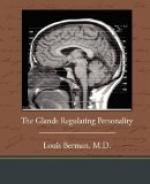CREATOR OF THE LAND ANIMAL
According to this conception the thyroid played a fundamental part in the change of sea creatures into land animals. Experimentally, thyroid has been used to transform one into the other. Thus the occasional change of a Mexican axolotl, a purely aquatic newt, breathing through gills, into the amblystoma, a terrestrial salamander, with spotted skin, breathing by means of lungs, has long been known. Feeding the axolotl on thyroid gland produces the metamorphosis very quickly, even if the axolotl is kept in water. In the reptile house at the London Zoological Gardens full-grown examples of the common black axolotl and the pretty white variety are exhibited. Some are nearly three inches long. Alongside are shown several examples of the amblystoma stage, produced in one of the laboratories of Oxford University and at the gardens by thyroid feeding. A variation of the thyroid in the direction of increased secretion was probably responsible for the first land animals.
THYROXIN, SECRETION OF THE THYROID
Under the microscope, as in the test tube, the thyroid shows remarkable and unique features. Closed spherules lined by a single layer of cells enclosing a gelatinous material known as colloid, which stains deeply with acid dyes, comprise the units of its architecture. Essentially, it may be pictured as a series of jelly bubbles secreted by outlying cells.
A relatively high percentage of iodine is the unique distinctive fact in its chemistry. Discovered by Baumann in 1895, the presence of the element has focused the intelligence of chemists upon the gland, with the consequent demonstration of arsenic also in it. It was soon manifest that the secretion of the gland was dependent upon the iodine content for its activity. Active extracts of the thyroid like thyreoglobulin and iodothyrin were proven to contain iodine, and to become inactive when the iodine was removed. Efforts to isolate the iodine containing active principle in pure form were fruitless until the work of Kendall at the Mayo Foundation. He obtained it as a white, finely crystalline, odorless and tasteless substance, heat stable, and analyzable. The free form separates as a sheaf of fine needles. Kendall at first called it the a-iodine compound, then named it thyroxin.
There are other internal secretions of the thyroid, with a function of their own, that have no iodine. But they are secondary, and obscure. Thyroxin is accepted today as the purified internal secretion of the thyroid because all the effects of the whole gland may be elicited with it. Thyroxin produces results with doses amazingly minute compared with the quantity of whole gland necessary. Moreover, a dose of thyroxin appears to last an organism in need of it over a period of time; the other has to be administered continuously.




